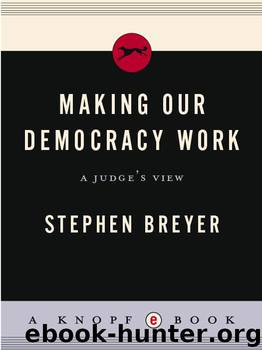Making Our Democracy Work by Stephen Breyer

Author:Stephen Breyer
Language: eng
Format: mobi, epub
ISBN: 9780307594266
Publisher: Knopf Doubleday Publishing Group
Published: 2010-09-14T10:00:00+00:00
NOW LET US return to our 1995 guns-in-schools case. The question was whether the Constitution’s commerce clause grants Congress the authority to enact a statute forbidding the possession of a gun near a local school. In deciding the case, the Court took as given certain long-held underlying legal principles. The commerce clause, for example, grants Congress the power to regulate items that move in interstate commerce and activities that affect interstate commerce. Moreover, when the Court determines whether an activity, say growing wheat for home consumption, has the required interstate effect, it must assume that Congress has the power to act in light of the total effect by aggregating instances of similar activity. Even though one farmer’s homegrown wheat supply would not affect the interstate price, an aggregation of all wheat that all farmers grow at home might well do so. Between 1938 and 1990, the Court, applying these and similar legal principles, consistently upheld federal statutes on the ground that the underlying activities significantly affected interstate commerce.11
The Court, however, struck down the federal statute making criminal the possession of a gun near a school. The Court said that education and crime were primarily local matters, that gun-related violence would primarily affect local communities, and that the criminal laws of the states could adequately deal with the gun-possession problem.12
Although there is a certain logic to that position, it is not difficult to find potential interstate effects that could justify making possession of a gun near a school a federal crime. Possession of guns in schools means violence, and violence means poor education. Poor education means an unproductive, noncompetitive workforce. And that kind of workforce negatively affects not just one state but all states. School violence, of which guns are a part, arguably presents a national problem warranting a national solution.13
Thus, we have two sets of logical links, pointing in opposite legal directions. Which should control the outcome of the Court decision? The answer requires the judge to make a decision about the importance of each of the underlying connections. That judgment must be informed by fact, and legislators are more likely to find those facts and better able to determine their policy relevance. That is why courts, aware of Brandeis’s four “truths,” should defer strongly to Congress’s judgment about such matters. And it is why a workable relation between state and federal governments depends in large part on courts granting Congress that deference.
In short, application of the subsidiarity principle to the legal problem of interpreting the Constitution’s list of federal legislative powers requires the Court to consider matters that are primarily empirical and are often matters of degree. And the Court is not well suited institutionally to make those kinds of determinations. Consequently, and not surprisingly, the Court’s decision in the gun case did not stop Congress from reenacting a virtually identical statute. This time the statute applied its strictures only to guns that had moved in, not just affected, interstate commerce. And virtually every gun satisfies that condition.14
The Court,
Download
This site does not store any files on its server. We only index and link to content provided by other sites. Please contact the content providers to delete copyright contents if any and email us, we'll remove relevant links or contents immediately.
Day by Elie Wiesel(2745)
The Age of Genius by A. C. Grayling(2555)
Gideon's Spies: The Secret History of the Mossad by Gordon Thomas(2318)
The Gulag Archipelago (Vintage Classics) by Aleksandr Solzhenitsyn(2064)
FATWA: Hunted in America by Pamela Geller(1982)
Columbine by Dave Cullen(1839)
Men Explain Things to Me by Rebecca Solnit(1705)
The Rule of Law by Bingham Tom(1667)
Anatomy of Injustice by Raymond Bonner(1639)
Examples & Explanations: Administrative Law by William F. Funk & Richard H. Seamon(1616)
Three Cups of Tea by Greg Mortenson(1595)
The Source by James A. Michener(1573)
That Every Man Be Armed by Stephen P. Halbrook(1556)
ADHD on Trial by Michael Gordon(1550)
Future Design by Unknown(1530)
Gideon's Spies by Gordon Thomas(1485)
Palestinian Walks by Raja Shehadeh(1480)
Constitutional Theory by Carl Schmitt(1427)
Nothing to Envy by Barbara Demick(1418)
